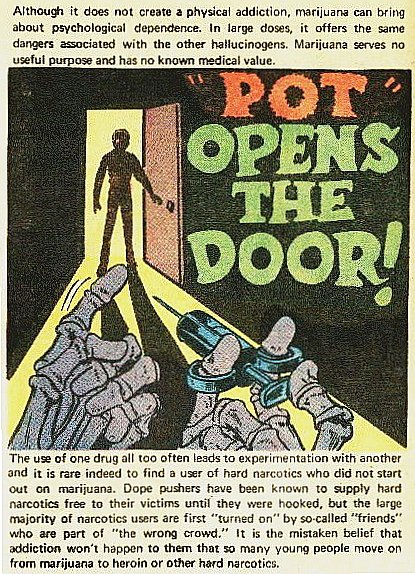NIDA: Themes in Chemical Prohibition, William L. White, 1979
http://www.druglibrary.org/schaffer/History/ticp.html
4.
The Concept of "Controlled" Usage is Destroyed and
Replaced by a "Domino [aka Stepping-Stone/Gateway] Theory" of
Chemical Progression,
All Use Is Abuse
The history of prohibitionist pronouncements is replete with

| |
This anti-drug ad illustrates the
theme of the gateway. Taking illegal methamphetamines
"even once" leads to smoking meth, which leads
to injecting meth, and so on.
("That Guy", Montana Meth Project)
|
examples which propose a "domino [gateway] theory" of
chemical usage. Such a theory holds that the use of a particular
drug (usually the one presently targeted for prohibition)
inevitably and with rare exception leads-to the use of other
drugs (usually drugs already prohibited or drugs already defined
as evil). For example, the publication in 1798 of
Essays, Literary, Moral and Philosophical by Benjamin Rush
includes the following comments from an anti-tobacco essay: "A desire of
course is excited for strong drink, (by smoking tobacco) and
these (cigarettes) when taken between meals soon lead to
intemperance and drunkenness.35 The following
is from a 1912 article in Century magazine:
The relation of tobacco, especially in the form of
cigarettes, and alcohol and opium is a close one . . .
Morphine is the legitimate consequence of alcohol, and alcohol
is the legitimate consequence of tobacco. Cigarettes, drink,
opium is the logical and regular series.
36
One of the most dramatic and all-inclusive examples of this
"domino theory" can be seen in the following
illustration from The Temperance Program (1915) of Evangelist
Thos. F. Hubbard. 37

snacking between meals is a gateway to a drunkard's grave (1915)
|
|

marijuana gateway (c.1970) Teen-Age Booby Trap - Comic Book from the US
Bureau of Narcotics & Dangerous Drugs
|
|
The contention that alcohol abuse was the basis for
morphinism was not uncommon in the late 1800's, and more
recently
the mystical connection between marihuana and heroin
has been central to the rationale for continued prohibition of
marihuana.
All Use Is Abuse, 2008
[ Here the idea is the political or criminal status of a drug
determines whether any and all use of the drug is to be
considered "abuse".
For example, this idea is concisely stated by
Steven Gans, MD
"Generally, when most people talk about substance abuse,
they are referring to the use of illegal drugs.
Most professionals in the field of drug abuse prevention argue
that any use of illegal drugs is by definition abuse.
Those drugs got to be illegal in the first place because
they are potentially addictive or can cause severe negative health effects;
therefore, any use of illegal substances is dangerous and abusive."
(What Is Substance Abuse?, Steven Gans, MD, about.com)
So, according to the all-use-is-abuse idea,
drinking a cup of coffee was abuse in
the 17th century in the state of Waldeck -
for the prince declared coffee to be illegal and even
paid informants to denounce coffee drinkers to the authorites.
(Griffith Edwards,
Psychoactive substances, The Listener, 1972)
Fortunately for us, the exact same behavior (drinking a cup of coffee)
now won't subject us to imprisonment - like it did then. ]
|
All Use Is Abuse
The destruction of the concept of controlled drug usage
implies that everyone who ever uses heroin will be a "dope
fiend," everyone who drinks will be an alcoholic, etc.
In
general this strategy equates the use and abuse of drugs and
implies that it is impossible to use the particular drug or
drugs in question without physical, mental, and moral
deterioration.
Such a view holds that there are powers within
the drug over which no one can exert control.
The extreme absurdity of such a view seems apparent when one considers the
vast majority of persons who use alcohol in this country with
minimal or no dysfunctional consequences and the numbers of
users of illicit drugs who do not suffer physical deterioration,
who do not progress to compulsive drug usage, who do continue to
work, raise children, and
maintain the usually expected social responsibilities.
The idea that there are overwhelming powers
within drugs is probably nowhere better illustrated than in a
statement in
Marc Olden's
1973 book, Cocaine,
in which he
states: "It's possible to get a habit just from handling
the drug."38 The continued belief in this domino theory of
chemical progression and its implications for current policies
is perhaps well illustrated by a 1974 survey in which 39 percent
of non-marihuana users in the sample cited
"marijuana use leads to harder drugs"
as the primary reason
for their opposition to legalization of marihuana.39
|